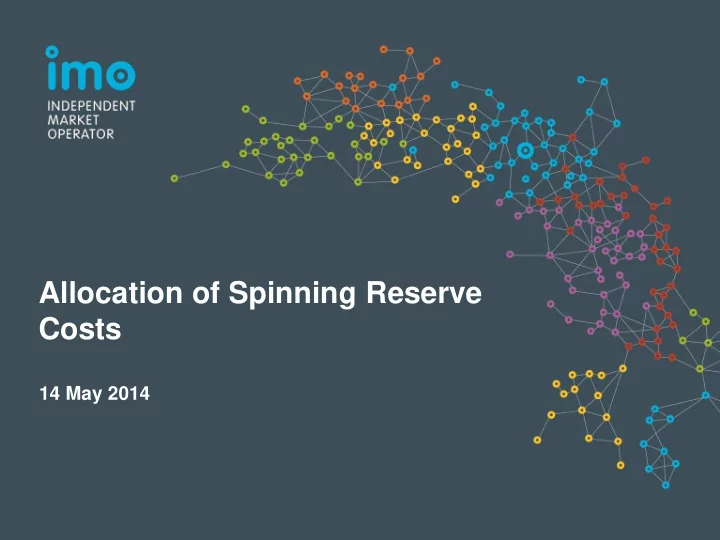

Allocation of Spinning Reserve Costs 14 May 2014
Background Spinning Reserve is the capacity of a group of Facilities that is held in reserve and can be activated by System Management to accommodate the loss of generation in the system with limited power flow and frequency variation. Under the Wholesale Electricity Market Rules (Market Rules), the level of Spinning Reserve must cover the greater of either 70 per cent of the total output of the largest Facility, or the maximum load ramp over 15 minutes. The current Spinning Reserve Requirement is determined and documented in the 2009 Ancillary Services Report and is not proposed to be changed as part of this proposal. Spinning Reserve can be provided by either: • Scheduled Generators that are synchronised to the network and are able to affect their active power to compensate for an unexpected increase or decrease in demand; or • Interruptible or Dispatchable Loads that can reduce load on request in the required timeframe.
Previous MAC Discussion At the 19 March 2014 Market Advisory Committee (MAC) meeting, Bluewaters Power presented a pre Rule Change Proposal to adjust the block boundaries (in Appendix 2 of the Market Rules) under which Spinning Reserve costs are allocated. The proposal included two options in an attempt to make the current cost allocation methodology more equitable: 1. to expand the size of blocks 1, 2 and 3; and 2. to combine the current blocks 4 and 5 into one block and split block 1 into two blocks. At the meeting, the MAC agreed to consider a third option of allocating Spinning Reserve costs - the full runway method.
Option 1: Current Modified Runway Method The cost of Spinning Reserve is currently allocated based on a modified runway method under which Facilities that have generated in a Trading Interval are allocated a proportion of the total cost dependent on the quantity it has produced in that Trading Interval. Appendix 2 of the Market Rules allocates: • a share of the total costs to each of five blocks (varying size); and • a share of the block costs to each Facility that produces a quantity within the MW range of that block, based on the block sizes in the table below. Block # MW > ≤ MW Block Size 1 200+ 330 100 2 125 200 75 3 65 125 60 4 45 65 20 5 10 45 35 4
Option 2A: Amending Current Method - Expanding Larger Block Sizes Proposed by Bluewaters Power in its pre Rule Change Proposal. The proposed option continues allocating costs based on a modified runway method but expands the size of blocks 1, 2 and 3 to increase the proportion of the total Spinning Reserve costs attributed to larger Facilities. In particular, it separates the 300MW+ Facilities from the units closer to 200MW. The proposed block sizes are provided in the table below. Block # MW > ≤ MW Block Size 1 235 335 100 2 135 235 100 3 65 135 70 4 45 65 20 5 10 45 35 5
Option 2B: Amending Current Method - Splitting Largest Block Size and Combining Smallest Block Size Proposed by Bluewaters Power in its pre Rule Change Proposal. The proposed option continues allocating costs based on a modified runway method but combines the current blocks 4 and 5 into one block and increases and splits block 1 into two blocks. This will increase the proportion of the total Spinning Reserve costs attributed to the largest Facilities and at the same time reduce the proportion allocated to the smallest Facilities. The proposed block sizes are provided in the table below. Block # MW > ≤ MW Block Size 1 275 350 75 2 200 275 75 3 125 200 75 4 65 125 60 5 10 65 55 6
Option 3: Adopting Full Runway Method Discussed by MAC at its March 2014 meeting. This method allocates total costs to Facilities that have generated in a Trading Interval, dependent on the quantity each Facility has produced in that Trading Interval. The full runway method continues to allocate costs on a causer pays basis but provides a more granular approach, which decreases the likelihood of price shocks as Facilities move into a different block under the modified runway approach. 7
December 2013 – Comparison of Options – Per Generator
February 2013/14 – Simulated Runway Model – Per Generator
December 2013 – Comparison of Options – Cumulative Represents the additional cost that Facility 1 pays for Spinning Reserve
February 2013/14 – Simulated Runway Model – Cumulative
Other Effects This analysis does not take into account the ability of generators to respond to a change in the Spinning Reserve cost allocation method as this would be a behavioural shift and is therefore not easily predicted or modelled. As such, the differences discussed in the above analysis do not indicate the degree to which generators’ allocated Spinning Reserve costs will increase or decrease in response to a change in the allocation method. For example, if the financial risk associated with moving into a higher block under the modified runway method decreased, Market Participants may be more likely to make additional capacity available.
Recommend
More recommend